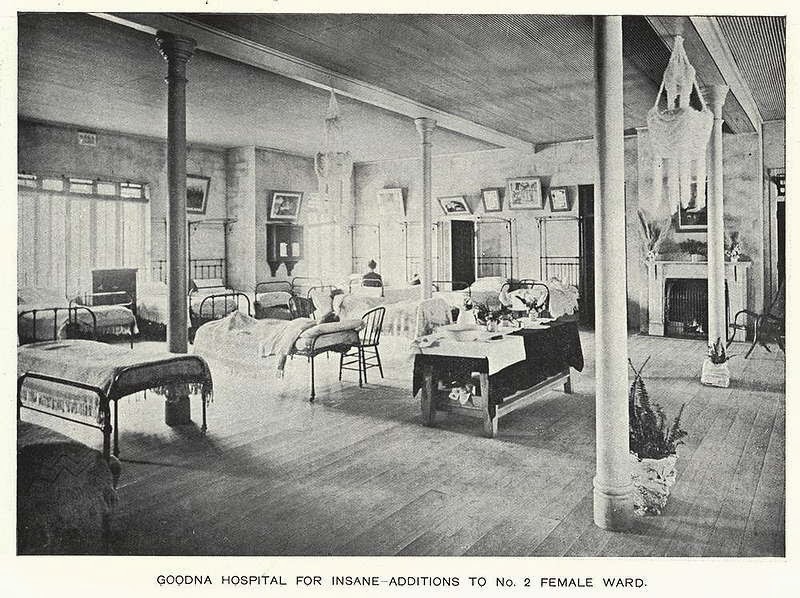I have been revisiting some of my old publications (for reasons that will become clear in the coming months) and have found that after a few years I can finally look at them with fresh eyes. It's surprising how much research I can do on something and then completely forgot about it a few years later.
Intemperance & the Train of Evilsis one of those books. It would be a great name for a Blues album, but instead it is a biography on the life of Margaret Blessington, who arrived in Brisbane as a 2-year-old back in 1874. After being brought up ‘on the wrong side of the tracks’ she led an institutionalised life in various venereal disease hospitals, ‘charitable institutions’, prisons and mental asylums. This went on for decades, because somehow Margaret managed to live into her eighties.
The book was written on the back of research I conducted during my postgraduate History studies at the University of Queensland. The project was to write a biography of a Queenslander and I chose Margaret for two reasons. Firstly because people like her left a massive footprint in the historical records as they moved from institution to institution and courtroom to prison cell. Secondly, a name like Blessington is easier to track through the records than Johnson. So I guess I was cheating a bit there in making my work easier. It did turn out to be a good choice because her life told a much wider story of the Brisbane underclass at the turn of the 20th century.
 Margaret was sent to prison at least 46 times, which might seem like a staggering amount but these were almost all short-term sentences (usually a few weeks) for offences such as drunkenness and prostitution (the coded official terminology for which was usually 'obscene language' or 'obscene exposure'). Some of her contemporary female prison colleagues were actually sentenced in excess of 100 times. It is clear they had become ‘habitualised’ to the merry-go-round of a few weeks on the streets followed by a few weeks in a cell. Sadly, for many this cycle was only broken by death or insanity.
Margaret was sent to prison at least 46 times, which might seem like a staggering amount but these were almost all short-term sentences (usually a few weeks) for offences such as drunkenness and prostitution (the coded official terminology for which was usually 'obscene language' or 'obscene exposure'). Some of her contemporary female prison colleagues were actually sentenced in excess of 100 times. It is clear they had become ‘habitualised’ to the merry-go-round of a few weeks on the streets followed by a few weeks in a cell. Sadly, for many this cycle was only broken by death or insanity.What surprised me during the course of the research was the sheer number of institutions there were in colonial Brisbane trying to ‘help’ women like Margaret. There again, there was obviously a lot of demand created by the awful working conditions that many women had to endure back then. Domestic Service was presented as something of an aspiration for these women, but that was a life of drudgery and semi-slavery, working long hours doing strenuous work in the homes of the middle and upper classes in return for a pittance. As was often commented at the time, it was no surprise that some sought refuge in the relative freedom of life as sex workers.
The course of Margaret’s life took her through such places as the Toowoomba and Brisbane prisons, the Fortitude Valley lock-up, the Lock Hospital, the Goodna Hospital for the Insane, the Ipswich Hospital for the Insane, Toowoomba Mental Hospital, and finally the Dalby Jubilee Hospital, where she died in 1957 at the age of 85 years. Other institutions she might have seen the inside of include the Female Refuge and Infants’ Home, the Toowoomba Industrial School and Reformatory, Brisbane Industrial Home, and The Magdalene Asylum.
 |
| Kit inspection, 1903 (John Oxley Library). Margaret Blessington is one of the prisoners in this photograph, which was taken on a day when she was confined in Brisbane Prison. |
 |
| This 1913 photograph gives a somewhat sanitized impression of the women’s ward at the Goodna Hospital for the Insane. (Brisbane City Council) |
 |
| The symmetrical grounds of the Toowoomba Hospital for the Insane, ca.1902 (John Oxley Library). This design was intended to reflect a sense of balance and order. |
Intemperance & the Train of Evils is one of my personal favourites, I think because in researching the lives of people like Margaret you come to feel you know them a bit,
There’s more than enough material out there on the lives of the rich and famous, and frankly it’s a side of history that I’m not really interested in. The wealthy ensured their historical remembrance with studio portraits and lavish grave memorials. People like Margaret tend to disappear between the cracks of History. There are no photographs (even her prison photo has been lost) and their graves usually lie unmarked. Uncovering the forgotten lives of the less fortunate is, in my opinion, a much more rewarding pursuit because in the process they become un-forgotten.You correct a little bit of the inherent bias within History towards the rich and powerful. Just a bit.
Maybe, given her circumstances, Margaret would have preferred historical anonymity, but her story tells us so much about the society she lived in. The lives of people like Margaret slipped by in a blur of 'corrective' institutions, alcohol, insanity and eventual anonymity.
Check a local bookshop for Intemperance & the Train of Evils: A life on the wrong side of the tracks in colonial Brisbane, or it can be bought online or by mail here.
Price: $10.00 (+$5.00 postage).
21,000 words, 84 pages.
Includes photographs, endnotes and appendices.
Foreword by Senator Claire Moore.
Foreword by Senator Claire Moore.
